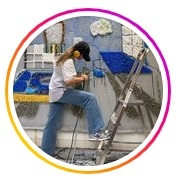SOPRA SOTTO, è una residenza artistica interdisciplinare e think tank creativo, il tema di quest'anno è stato “Sensi e sostenibilità”.
Un gruppo di artiste e creative interdisciplinari si riunisce a La Tegolaia in Toscana per analizzare e trovare un buon compromesso fra due temi che oggi sono sempre più ricorrenti consumismo e coscienza ambientale.
Con Constance Van Berckel, ideatrice del progetto e il supporto di Alessia Pasquini, abbiamo incontrato le sei artiste-designer olandesi nella nostra libreria di Firenze e gli abbiamo fatto delle domande sul tema.
In questa PART.1 presentiamo Phlox van Oppen, una designer tessile laureata alla Royal Academy of Art dell’Aia.
È specializzata in riciclo, upcycling e sostenibilità e crea materiali innovativi dai rifiuti di tutti i giorni.
1) How does your background as a textile designer integrate with your passion for recycling and upcycling?
In 2022 I graduated from the KABK as a textile artist.In my generation, where recycling, upcycling, sustainability, and other ecological terminology have become commonplace, I have been inspired by everyday materials that are often overlooked. Having lived in the largest female student house in the Netherlands with 36 girls, I found inspiration within the daily household, which led me to conduct research on various materials, ecosystems, and waste on a continue basis.
2) How do you create innovative materials from everyday waste?
During the pandemic, as a student, the need for creativity and innovation with available materials became apparent. Recognizing the abundance of existing materials and daily waste, I began to explore and repurpose what was already present in my surroundings. I am motivated to challenge conventional notions of materialism. In a world overflowing with materials, it's crucial to rethink our approach and explore what's already around us instead of constantly relying on new resources. There's immense potential in re-using leftover materials. I draw inspiration from everyday life and materials. From cutting up old clothes to examining fabrics already in our homes or considering what we find in the tumble dryer. Even the plastic packaging we discard daily can find new life as materials. I deconstruct and reimagine these materials using a variety of techniques, including tufting, needle felting, knitting, weaving, embroidering, crocheting and knotting.
3) How does your focus on sustainability translate into the choice of materials and production processes?
It's essential for us to actively contribute to a more sustainable future by carefully considering both the materials we utilize and the methods by which we process them. Frequently, I gather or receive discarded materials, embarking on a process of experimentation using various techniques to unravel, cut, and return them to their base form. Exploring diverse processes for utilizing these materials and textiles allows me to discover the most effective ways to incorporate them into my techniques. Currently, I'm engaged in a project involving bracelets from the Dutch Design Week, an internationally renowned art festival in the Netherlands, where I'm exploring all possibilities in unraveling and experimenting with different techniques.
4) How can your work contribute to creating a more sustainable world?
My journey in textiles has been characterized by my commitment to sustainability and my desire to work with unconventional materials. I see art as a way to deeply connect with nature and our surroundings. My way of working revolves around repurposing discarded materials into artworks. Whilst aiming to provide a mirror for society focusing on environmental issues, such as overconsumption in the clothing industry.By using the beauty of waste to start the conversation about the aim to create a more sustainable world.
5) What are you hopes for the future of sustainable fashion?
My hopes for the future of fashion and textiles lie in a collective awakening towards more conscious buying behavior.I envision a shift towards valuing sustainability over fleeting trends, where consumers prioritize ethical practices. Informed by insights from the residency SOPRA SOTTO, like the significance of using pure fiber combinations, I advocate for repurposing discarded garments for extended lifespans. Through increased consumer awareness of sustainable alternatives, we can cultivate a fashion industry that values longevity and ethical practices.
6) What new technologies and innovations do you see emerging in this field?
During the SOPRA SOTTO residency, we had the opportunity to visit several companies in Prato that specialize in reusing clothes and transforming them back into fibers, such as Goritex. It was fascinating to witness these companies' efforts to repurpose nearly every component of discarded garments. Additionally, our visit to Galeotti Piume, a company that sources feather waste from the meat industry for big brands, showcased innovative methods to minimize waste, with surplus material being utilized for compost. Companies like these represent the future of sustainable fashion and textile for me, paving the way for more environmentally conscious practices in the industry.
